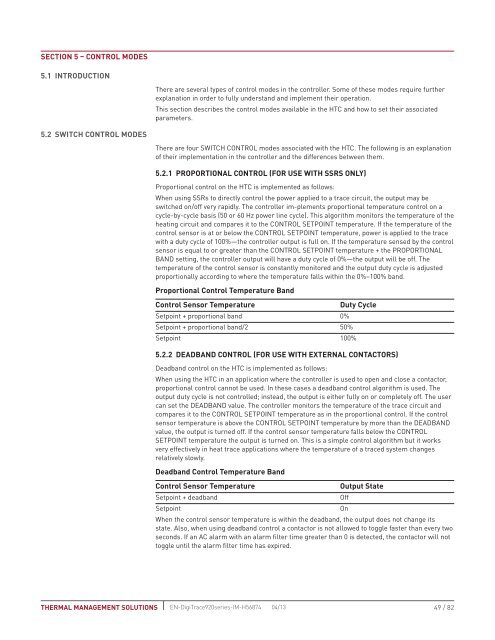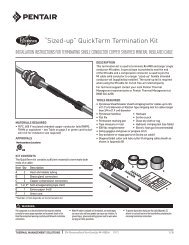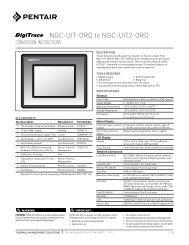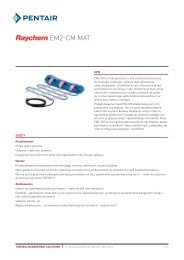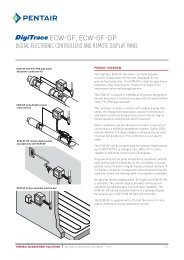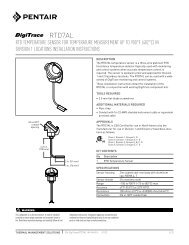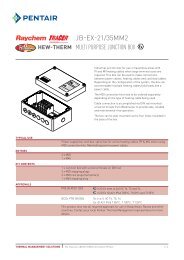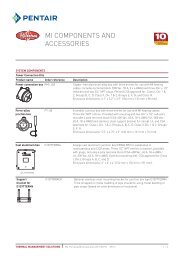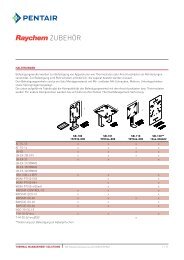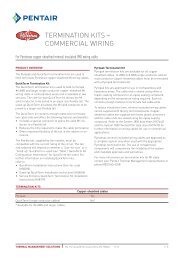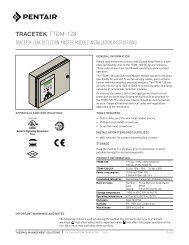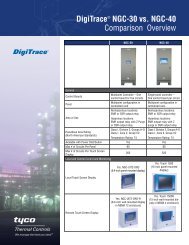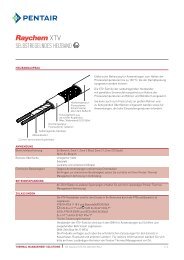DigiTrace 920 Series Heat Trace Controller - Pentair Thermal ...
DigiTrace 920 Series Heat Trace Controller - Pentair Thermal ...
DigiTrace 920 Series Heat Trace Controller - Pentair Thermal ...
Create successful ePaper yourself
Turn your PDF publications into a flip-book with our unique Google optimized e-Paper software.
Section 5 – Control Modes5.1 IntroductionThere are several types of control modes in the controller. Some of these modes require furtherexplanation in order to fully understand and implement their operation.This section describes the control modes available in the HTC and how to set their associatedparameters.5.2 Switch Control ModesThere are four SWITCH CONTROL modes associated with the HTC. The following is an explanationof their implementation in the controller and the differences between them.5.2.1 PROPORTIONAL CONTROL (FOR USE WITH SSRS ONLY)Proportional control on the HTC is implemented as follows:When using SSRs to directly control the power applied to a trace circuit, the output may beswitched on/off very rapidly. The controller im-plements proportional temperature control on acycle-by-cycle basis (50 or 60 Hz power line cycle). This algorithm monitors the temperature of theheating circuit and compares it to the CONTROL SETPOINT temperature. If the temperature of thecontrol sensor is at or below the CONTROL SETPOINT temperature, power is applied to the tracewith a duty cycle of 100%—the controller output is full on. If the temperature sensed by the controlsensor is equal to or greater than the CONTROL SETPOINT temperature + the PROPORTIONALBAND setting, the controller output will have a duty cycle of 0%—the output will be off. Thetemperature of the control sensor is constantly monitored and the output duty cycle is adjustedproportionally according to where the temperature falls within the 0%–100% band.Proportional Control Temperature BandControl Sensor Temperatureduty CycleSetpoint + proportional band 0%Setpoint + proportional band/2 50%Setpoint 100%5.2.2 DEADBAND CONTROL (FOR USE WITH EXTERNAL CONTACTORS)Deadband control on the HTC is implemented as follows:When using the HTC in an application where the controller is used to open and close a contactor,proportional control cannot be used. In these cases a deadband control algorithm is used. Theoutput duty cycle is not controlled; instead, the output is either fully on or completely off. The usercan set the DEADBAND value. The controller monitors the temperature of the trace circuit andcompares it to the CONTROL SETPOINT temperature as in the proportional control. If the controlsensor temperature is above the CONTROL SETPOINT temperature by more than the DEADBANDvalue, the output is turned off. If the control sensor temperature falls below the CONTROLSETPOINT temperature the output is turned on. This is a simple control algorithm but it worksvery effectively in heat trace applications where the temperature of a traced system changesrelatively slowly.Deadband Control Temperature BandControl Sensor TemperatureOutput StateSetpoint + deadbandOffSetpointOnWhen the control sensor temperature is within the deadband, the output does not change itsstate. Also, when using deadband control a contactor is not allowed to toggle faster than every twoseconds. If an AC alarm with an alarm filter time greater than 0 is detected, the contactor will nottoggle until the alarm filter time has expired.THERMAL MANAGEMENT SOLUTIONS EN-<strong>Digi<strong>Trace</strong></strong><strong>920</strong>series-IM-H56874 04/1349 / 82


